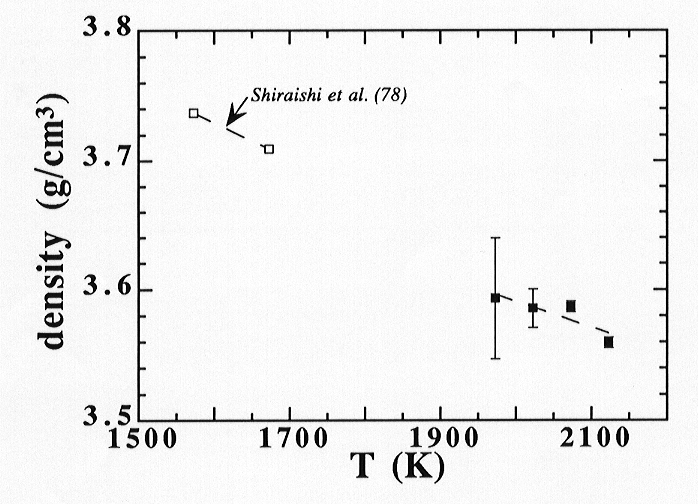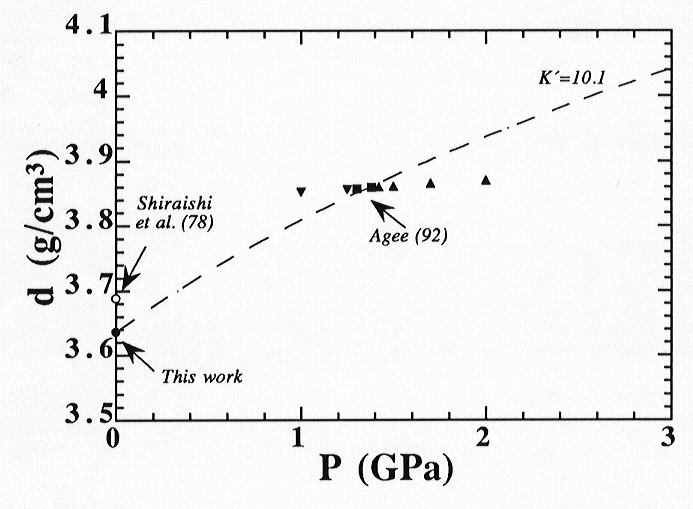

Understanding the evolution of the Earth´s interior via magmatic processes requires precise high-pressure high-temperature data on densities of silicate melts, especially of fayalite melt since fayalite melt represents a major constituent of most natural magmas. Combined with high-pressure densities from static determinations, experimental one-atmosphere densities provide a firm constraint for extrapolation of the densities of magmatic melts to higher pressures.
One-atmosphere density measurements in equilibrium with air and at high
temperatures were thus conducted on fayalite melt using the Ir-based double-bob
Archimedean method. Densities of the present mantle melt range from 3.59
to 3.56 g/cm3 over temperatures ranging from 1973 to 2123 K
as plotted in Fig. 3.6-8. Experimental densities are quite well documented
for this compound, but most of the previous studies were conducted using
the "maximum bubble pressure" method. In fact, it has been proposed that
discrepancies can be caused by the oxygen pressure in the bubble forming
gas and the temperature inhomogeneity of the melt in such a "maximum bubble
pressure" method. On the other hand, Shiraishi et al., 1978 (Trans.
Jap. Inst. Metal., 19, 264) have reported their density data performed
in an argon atmosphere using the double-bob Archimedean method over a temperature
interval ranging from 1573 to 1673 K, also plotted in Fig. 3.6-8, in which
bobs and crucibles were iron. Their measurements were performed at temperatures
much lower than ours because these two studies were made at different redox
conditions (i.e., under argon for Shiraishi et al. and under air in this
work). Shiraishi et al. estimated their sample to be almost fully reduced,
whereas the ferric/ferrous ratio calculated from literature models suggests
0.46 at 1973 K and 0.33 at 2073 K. Extrapolation of the data of Shiraishi
et al. to the temperature range investigated in this study match the present
one well, even though these two studies suggest slightly different thermal
expansion coefficients. Based on two experiments at temperatures differing
more than 100 K, Shiraishi et al. calculated a thermal expansion coefficient
for fayalite melt of 7.13 x 10-5 K-1, which is larger
than the one obtained in the present study (i.e., 5.7 x 10-5
K-1), assuming that all the Fe is as FeO within the temperature
range investigated.
 |
Fig. 3.6-8: One-atmosphere experimental densities of molten fayalite. In addition, the densities measurements of Shiraishi et al., 1978 are also plotted. |
Together with the high-pressure measurements of Agee 1992 (G.R.L.,
19, 1169), the present one-atmosphere experiments allow straightforward
interpolations in a large area of P-T space and thus provide
firm constraints on the isothermal compression curves. Fitting the third
order Birch-Murnaghan equation of state to both the high-pressure densities
and the new one-atmosphere densities yield a new isothermal compression
curve for molten fayalite (Fig. 3.6-9), in which the unknown parameters
are the isothermal bulk modulus (KT) and its
pressure derivative (K´T). A new value
for the isothermal bulk modulus of 17.2 GPa is found at 1773 K taking the
same pressure derivative of 10.1 as Agee. Agee determined previously an
isothermal bulk modulus of 24.4 GPa and its pressure derivative of 10.1
for fayalite melt at 1773 K by constraining its high-pressure data to one
atmosphere with the density measurements of Shiraishi et al. This present
KT is 30% smaller than the one obtained by
Agee.
 |
Fig. 3.6-9: The isothermal compression curve at 1773 K of molten fayalite calculated from the third order Birch-Murnaghan equation of state using static experiments of Agee, 1992. The static results have been reported by an arrow up, an arrow down and a square indicating the floating, the sinking and the neutral buoyancy of density markers, respectively. One-atmosphere experimental density of Shiraishi et al., 1978 extrapolated to 1773 K is also plotted. |

Tel: +49-(0) 921 55 3700 / 3766, Fax: +49-(0) 921 55 3769, E-mail: bayerisches.geoinstitut(at)uni-bayreuth.de
 Previous page
Previous page